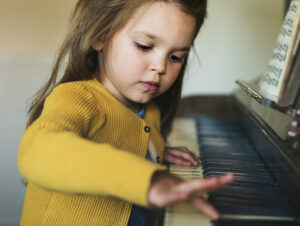If you’re wondering where to start learning piano, you’re not alone. As teachers who specialize in helping beginners—especially young learners—we’ve seen how overwhelming those first few steps can feel. But here’s the good news: learning piano starts with just one note, one rhythm, and one confident smile.
Let’s walk through exactly how we get started in our private lessons so you can feel ready and excited.
Step 1: Set Up a Comfortable Space
You don’t need a grand piano or a fancy studio. You just need:
- A digital or acoustic piano with 61+ keys
- A sturdy bench at the right height
- Good lighting and a quiet atmosphere
We want students to feel relaxed and focused. That means no distractions—and feet flat on the floor!
Step 2: Learn Your Posture and Finger Numbers
Before playing a single note, we teach students how to sit with proper posture and identify each finger by number (thumb is 1, pinky is 5). This lays the foundation for all future technique.
Step 3: Start with Middle C and Simple Rhythms
Most method books begin with Middle C because it’s easy to find and helps orient students on the keyboard. We also introduce:
- Quarter and half notes
- Basic rhythms through clapping games
- Simple songs using just three notes
For example, “Hot Cross Buns” is a favorite for our first week!
Step 4: Read Music Slowly and Steadily
Reading sheet music can feel like learning a new language—but don’t worry. We start with one line of music at a time. Flashcards and mnemonic devices like “Every Good Boy Does Fine” help make reading fun.
If you’re still deciding how to begin, our guide to starting piano lessons on the right foot breaks down what to expect in your first few lessons.
Step 5: Build Confidence With Encouragement
The most important part of learning piano isn’t speed—it’s consistency and support. Whether your child is 5 or 55, we focus on creating a joyful learning environment where mistakes are part of the process.
And if you’re looking for more advice, the National Association for Music Education offers excellent resources on early music education and developmental benchmarks.
FAQ: Where To Start Learning Piano
Can I learn piano without reading music?
You can start by playing by ear, but learning to read music will open up more repertoire and long-term success.
How much practice is needed at the beginning?
Start with 10–15 minutes a day, 3–5 days a week. The key is building a habit.
What’s better for beginners: digital or acoustic piano?
Both work! A digital piano with weighted keys is a great beginner option if you’re not ready to invest in an acoustic.
